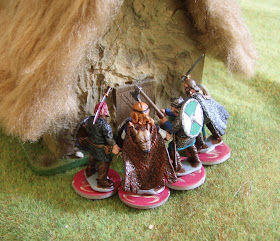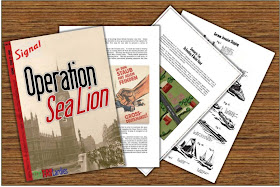...a battle report for our recent Viking Skirmish game.
Where: Northumberland in the late 9th century.
Who: Raiding Vikings, bands of Saxons, a Saxon long hall and some loot (5 Players, each with 5 figs)
What: Grab the loot - every warband for itself!
The Rules: We went old school with this one. REALLY old school. Donald Featherstone's
Skirmish Wargaming!
Forces: We each had 5 warriors: 1 Veteran, 1 Novice and rolled for the other 3 figures (d6: 6=Vet, 5-2=Av, 1=Novice) Figures as armed - each warband had 1 bowman and the rest with swords and axes, and a combination of armour and shields.
Setup: 1 warband setup in the Long Hall itself, the other four came in from different table edges. You can see that all players took a historically subtle approach to planning their raid!
(click for larger versions of pics)
So what happened?
Early moves- mostly everyone just running their warbands on. The Lad's archer did a snap shot on the run and got a wound on one of Steve's warriors. In reply, Steve's veteran bowman put a shaft into the Lad's archer's head - that was the end of that archery duel!
 |
| My warband advances with the bowman on the high ground (chap on the left already has a headache). The Lad's warriors are in the background |
|
In the meantime, my archer sought out the high ground, drew a bead on one of Pete's warriors and promptly broke his bowstring (I rolled a perfect '00' on a percentile dice!!!! Everyone agreed that meant something bad...)
The Approach - typically, everyone yelled very loudly and charged. The Lad's warriors collided with Pete's next to the Hut and the expected bloodletting ensued...
 |
| Shieldwalls crash together!!! |
 |
| The Lad's lads are victorious! |
Wounds were pretty decisive I must admit. A serious wound and KOed for 6 turns doesn't leave must scope for coming back into the game. Accordingly, the Lad decided it was time to just loot the twitching bodies and make off with their weapons and armour.
Breaking down the door In all the chaos, I maneuvered my guys to the front door and managed to batter it down
over a turn or two
.
 |
| Ding-dong: Avon Ladies! |
Then it was time to form a Viking conga line and fight our way in, with the defenders ready and waiting for us...
 |
| Viking gate crashers, while the Lad's last chap continues to loot the bodies outside |
Inside the Hut:
A nasty little surprise actually - the Saxons had hired no other than Xena and Gabrielle to help defend their hearth and home! Being good Vikings of course, we don't mind fighting women either so we got to work.
The finale
While all this was going on, Pete's last remaining figure decided discretion was the better part of valour, and Steve's warband (unengaged until now) had manoeuvred to ambush me on the way out of the hut. The Lad's chap outside had now plundered all the bodies and to keep him interested I gave him my archer figure who I had left on the hill with the broken bowstring. He ran the archer off the cliff, nimbly springing to his feet, ran over to the dead bowman with an arrow in his head, swapped over bows, lit an arrow and fired the thatch roof of the hut....while I was still in it!!!
Curse his inevitable betrayal...but it was good to see that essential fire component of the Viking raid wasn't missed.
At this point all figures scattered and ran off, while victory ales celebrated the various feats of the brave warriors on this day!
Overall
GREAT fun had by all, the figs and terrain worked very well together, and the simple rules were the key to quick and easy play. Probably just need to add a defensive factor for the extra protection of a shieldwall, but that's all. Whole battle took maybe 90mins.
Figures and Models:
All models are Wargames Factory Vikings and Saxons, beautifully painted up my mate Ken - I'll post some detailed, posed shots this week. Hills and Long House made by me. Menhirs by Fenris Games (and lovely they are too). My GW mat has been through some tough times over the years including about 6 house moves. I like its rough, realistic look though.
































